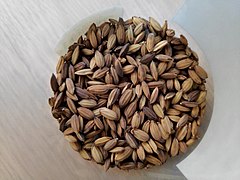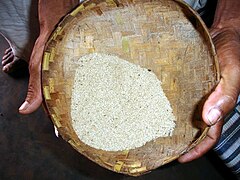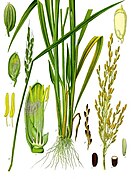Oryza sativa is much the more common of the two rice species cultivated as a cereal, the other species being O. glaberrima, African rice. It was first domesticated in the Yangtze River basin in China 13,500 to 8,200 years ago.[2][3][4][5]
| Oryza sativa | |
|---|---|
 | |
| Mature seed heads | |
 | |
| Inflorescence | |
| Scientific classification | |
| Kingdom: | Plantae |
| Clade: | Tracheophytes |
| Clade: | Angiosperms |
| Clade: | Monocots |
| Clade: | Commelinids |
| Order: | Poales |
| Family: | Poaceae |
| Genus: | Oryza |
| Species: | O. sativa |
| Binomial name | |
| Oryza sativa | |
| Synonyms[1] | |
List
| |
Oryza sativa belongs to the genus Oryza and the BOP clade in the grass family Poaceae. With a genome consisting of 430 Mbp across 12 chromosomes, it is renowned for being easy to genetically modify and is a model organism for the study of the biology of cereals and monocots.[6]
Description
editO. sativa has an erect stalk stem that grows 80–120 cm (30–45 in) tall, with a smooth surface. The leaf is lanceolate, 15–30 cm (5+7⁄8–11+3⁄4 in) long, and grows from a ligule 10–20 mm (3⁄8–3⁄4 in) long.[7]
- Water buffalo ploughing a rice paddyfield, Java
- Jumli Marshi, brown rice from Nepal
- Traditional rice of Niyamgiri Hills, India
- From Chhattisgarh
- Stem cross section magnified 400 times
Classification
editThe generic name Oryza[8] is a classical Latin word for rice, while the specific epithet sativa means "cultivated".[9][10]
Oryza sativa contains two major subspecies: the sticky, short-grained japonica or sinica variety, and the nonsticky, long-grained indica [zh] [ja] rice variety. Japonica was domesticated in the Yangtze Valley 9–6,000 years ago,[11] and its varieties can be cultivated in dry fields (it is cultivated mainly submerged in Japan), in temperate East Asia, upland areas of Southeast Asia, and high elevations in South Asia, while indica was domesticated around the Ganges 8,500–4,500 years ago,[11] and its varieties are mainly lowland rices, grown mostly submerged, throughout tropical Asia. Rice grain occurs in a variety of colors, including white, brown, black, purple, and red rices.[12][13]
A third subspecies, which is broad-grained and thrives under tropical conditions, was identified based on morphology and initially called javanica, but is now known as tropical japonica. Examples of this variety include the medium-grain 'Tinawon' and 'Unoy' cultivars, which are grown in the high-elevation rice terraces of the Cordillera Mountains of northern Luzon, Philippines.[14]
Glaszmann (1987) used isozymes to sort O. sativa into six groups: japonica, aromatic, indica, aus, rayada, and ashina.[15]
Garris et al. (2004) used simple sequence repeats to sort O. sativa into five groups: temperate japonica, tropical japonica and aromatic comprise the japonica varieties, while indica and aus comprise the indica varieties.[16] The Garris scheme has held up against newer analyses as of 2019,[17] though one 2014 article argues that rayada is distinct enough to be its own group under japonica.[18]
Genetics
editSPL14/LOC4345998 is a gene that regulates the overall architecture/growth habit of the plant. Some of its epialleles increase rice yield.[19] An accurate and usable simple sequence repeat marker set was developed and used to generate a high-density map.[20] A multiplex high-throughput marker assisted selection system has been developed but as with other crop HTMAS systems has proven difficult to customize, costly (both directly and for the equipment), and inflexible.[20] Other molecular breeding tools have produced rice blast resistant cultivars.[21][22][20] DNA microarray has been used to advance understanding of hybrid vigor in rice, QTL sequencing has been used to elucidate seedling vigor, and genome wide association study (GWAS) by whole genome sequencing (WGS) has been used to investigate various agronomic traits.[20]
In total, 641 copy number variations are known.[20] Exome capture often reveals new single nucleotide polymorphisms in rice, due to its large genome and high degree of DNA repetition.[20]
Resistance to the rice blast fungus Magnaporthe grisea is provided by various resistance genes including Pi1, Pi54, and Pita.[23] O. sativa uses the plant hormones abscisic acid and salicylic acid to regulate immune responses. Salicylic acid broadly stimulates, and abscisic acid suppresses, immunity to M. grisea; success depends on the balance between their levels.[24][25]
O. sativa has a large number of insect resistance genes specifically for the brown planthopper.[26] As of 2022[update], 15 R genes have been cloned and characterized.[26]
See also
editReferences
editExternal links
edit Data related to Oryza sativa at Wikispecies
Data related to Oryza sativa at Wikispecies Media related to Oryza sativa at Wikimedia Commons
Media related to Oryza sativa at Wikimedia Commons







